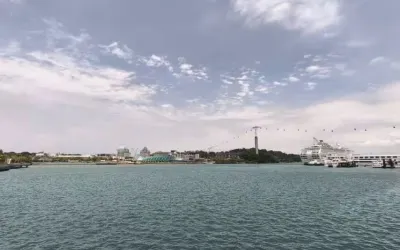新加坡为什么如此富裕?
Singapore is a tiny country, so tiny you can drive across the island in just an hour. Despite its size and lack of natural resources, Singapore's 5.6 million people enjoy one of the highest average incomes in the world ahead of countries like Germany, France and Japan.
新加坡面积较小,驱车一小时便能横穿这个岛国。虽然它地域有限、缺乏自然资源,但这里的人均收入水平要高于德国、法国和日本。
So how did this little island got so rich? Singapore doesn't have resources like coal or oil, but it does have something countries cann't buy, location. The island sits in the middle of an important re route connecting Asia to Europe. That's a key reason why the Britain decided, back in 1819, to set up a colony in Singapore. Location isn't everything though. There are several countries nearby that could have made use of their whereabouts, but they weren't quiet successful. That's because there are other ingredients that go into this crazy rich Singapore recipe. The Raffles Hotel which is one of the most prominent icons of Singapore's colonial history. Unlike some of its neighbors which wanted to separate themselves from their colonial histories, Singapore kept close ties with Britain even after independence in 1965. That decision announced to the rest of the world that Singapore was open for business.That's important because we know now that exports help to grow and expand an economy. But back then, it wasn't conventional wisdom. Singapore, Hong kong, Taiwan and south Korea became known as the four Asian tigers, which has grown rapidly since the 1960s. Their rise was fueled by exports, industrialization and more crucially, big doses of government intervention. That was especially true for Singapore.
为什么这个小小的岛国会这么富有呢?新加坡没有煤炭、石油,但它享有无法用钱买到的资源--地理优势。这也是1819年英国决定在这里建立殖民地的主要原因。然而地理位置并不是全部原因,新加坡的几个邻国也具有这项优势,但他们并没有取得很大成功。在烹制富豪新加坡的菜谱中还需要其他的食材。莱佛士酒店是新加坡的殖民历史的重要标志之一。
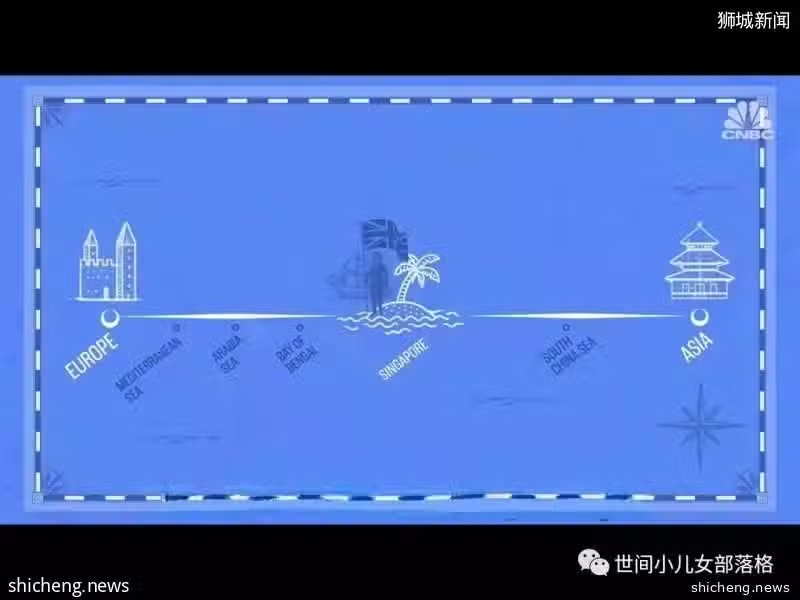
不同于那些急于摆脱殖民历史的邻国,即使是在1965年独立以后,新加坡仍与英国保持着密切的合作关系。这项决策等于向全世界宣布新加坡对外开放商业贸易。对外开放意味着经济体能够发展壮大,这一点十分重要。但是这在当时看来确实不符合传统观念。自上世纪60年代新加坡、香港、台湾和韩国不断发展,成为亚洲四小龙。它们的崛起靠的是对外开放、工业化以及最重要的--政府干预。对新加坡来说更是如此。
Labor strikes were common on the island in the 1960s, even with high employment. On Top of that there was a housing crisis, with Singapore being home to one of the largest slum settlements in the world.So how do you build a more disciplined labor force to attract investment? Well, you give them something to work for, like a house of their own, which is why one of the first Singapore government agencies set up focused on building affordable public housing. While just 9% of the population live in public housing in the 1960s, that figure stands at more than 80% today, add in greater employee rights and strikes became extremely rare. At the same time the government attracted foreign investment through tax incentives, growing the economy and easing unemployment, which fell from an estimated 14% in 1959 to 4.5% in the 1970s. By the 1980s, Singapore was a regional manufacturing hub, and it was the world's biggest producer of hard disk drives. But today, manufacturing makes up only about 20% of singapore's GDP.
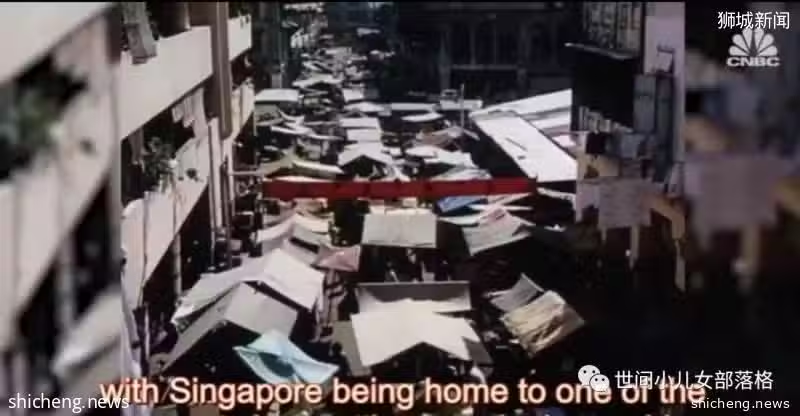
上世纪60年代新加坡的就业率很高,但工人罢工的现象依然很普遍。此外新加坡当时是世界最大的贫民聚集地之一,面临住房危机。那应该如何建立一个更为行之有效的劳工制度来吸引投资?首先你需要让他们有能够为之奋斗的事物,比如属于自己的房子。这就是新加坡的第一届政府确立后把重心放在建设经济型公共住房的原因。当时居住在公共住房的人数只占总人口的9%,但现在这个数字已经超过80%;再加上雇员权利的保障,罢工现象很少出现。与此同时政府实行捐税政策不断吸引外商投资,使经济不断增长,就业压力得以缓解--失业率从1959年的14%左右,在1970年以后降低至4.5%。到上世纪80年代新加坡已经成为区域制造业中心,还是世界上最大的硬盘生产地,但现在制造业只占新加坡GDP20%左右。
Take a look at singapore's growth in GDP. You can see two big surges, one beginning in the late 80s and another at the start of the new millennium. Ironically, Singapore has a downturn to thank for that. You see in 1985 Singapore went into its first post independence resource recession, prompting the government to introduce measures.State-owned companies like telecommunication were privatized to make them more competitive. Then at the turn of the century, service industries like finance and insurance were father liberalized. That openness have to grow the share of services from just 20 percent of GDP in 1985 to more than 70 percent in 2017. Multinational companies began to set up regional headquarters in Singapore. That attract even bigger players, boosting singapore's attractiveness to corporate and in turn its GDP. Now , Singapore is ranked as one of the world's easiest places to do business.
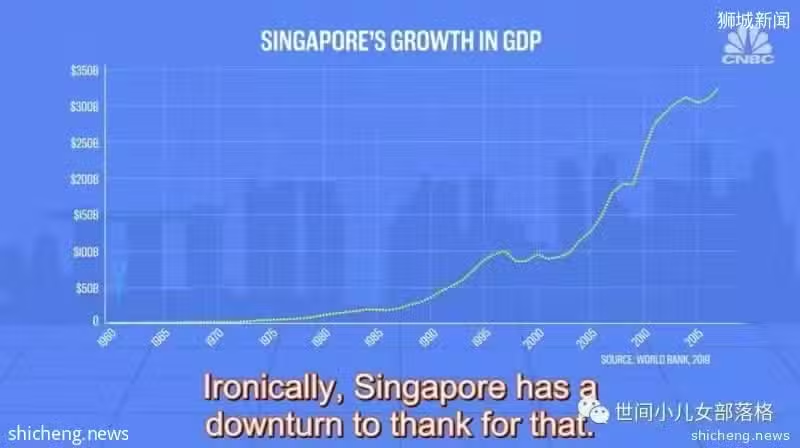
仔细看新加坡的GDP增长曲线,就能发现有两处增长点:第一个始于80年代末,另一个在2000年初。然而新加坡还得庆幸这两个时间段之间的一次滑坡。新加坡在1985年经历了后独立时期的资源衰竭,这促使政府寻找新的解决方案。一些国有企业例如通讯公司实行私有化,增加其竞争力;之后在21世纪初,金融和保险等服务业更加自由化。服务业的开放使其在GDP的占比从1985年的20%增长至2017年的70%。跨国公司开始纷纷在新加坡建立区域总部。这一发展趋势吸引了更大的投资者,大幅提升了新加坡贸易合作的吸引力及其GDP。现在新加坡在全球是投资最便意的国家。
Singapore has been praised for transforming itself from a developing to developed economy. But most singaporeans feel rich? Well, not exactly. Two of the most important reasons? The high cost of living and inequality. For five years in a row Singapore has been named the world's most expensive city, ahead of New York and London. That's largely because of taxes on cars, making Singapore the most expensive place in the world to buy and run an automobile. It's also the third most expensive place on earth to buy clothes. But personal care, household goods and domestic help in Singapore tend to be less expensive than in other major cities. While Singapore is rich in terms of GDP per capita, the median monthly salary is $3,270. That doesn't sound too bad, but about 20% of that goes into a mandatory savings account. You can use that account to pay for a medical bills, housing and education, but it does restrict the purchasing power of the population.
新加坡成功将其从发展中国家发展为发达国家,广受赞誉。但是不是大多数的新加坡人都非常富有呢?很遗憾,并不是。这主要有两方面的原因:高消费和不平等。新加坡已经连续五年被评为世界消费最高的城市,位列纽约和伦敦之前,其主要原因是对汽车收税较高,使得新加坡购买和使用汽车的费用成为世界之最。此外,新加坡的服装价格也位列世界前三,但其在个人护理、生活用品、家政服务方面的消费水平与其他发达国家相比较低。新加坡的人均GDP很高,中等收入者每月的平均工资约3270美金。听起来还不错,但是其中的20%都要强制存入一个账户,用于医疗、住房、教育的支出,不过这一举措也限制了国民的购买力。
You probably heard of the movie Crazy Rich Asians,which was set here in Singapore. And there was no wonder. Because Singapore has about 184,000 millionaires, making it truly is the land of the crazy rich. That's great news. The Singapore also has a fairly high rate of inequality compared with other developed countries. Let's look at the Gini coefficient, which is a scale used to calculate inequality, With zero being the most equal and one being the least. Singapore's Gini coefficient, after accounting for taxes and transfers was 0.356 in 2017. That was worse than countries like the United Kingdom, Japan, Korea and Germany, although it fared better than some, like the United States. Is that number really that bad? That question had books like this flying off the shelves. A think tank ignited public debate on the divide in social classes, after it found that on average, Singaporeans who live in public housing have fewer than one friend who lives in private housing. The government has caused the issue of inequality a national priority, but it remains to be seen if it is a problem that can be tackled effectively.
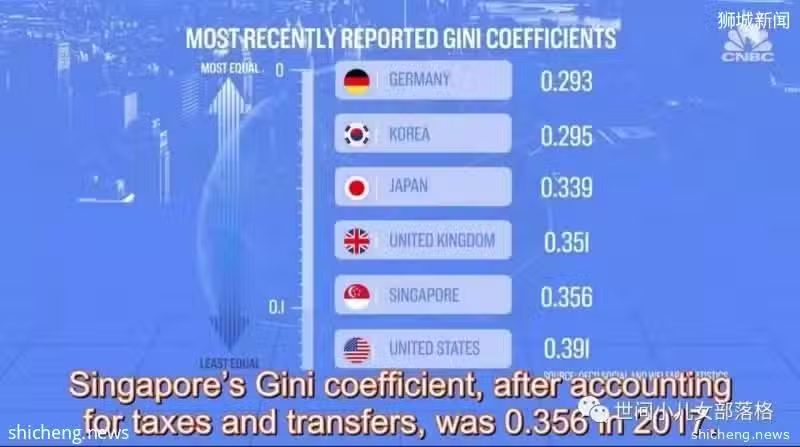
很多人都知道电影《亚洲富豪》,它的拍摄地就在新加坡。新加坡的百万富翁大约有18.4万,毫无疑问,它是当之无愧/名副其实的富庶之地。但同时令人感到惊奇的是,在发达国家中新加坡的不平等程度相当高。经过对税务和资金流动进行核算,2017年新加坡的基尼系数(用来表示不平等程度的度量单位,"0"表示最平等,"1"表示完全不平等)达到0.356,这比英国、日本、韩国、德国等国家情况要差,比美国的情况稍好一些。这个数字是不是真有这么糟呢?确实如此,关于新加坡不平等现象的书籍《This is What Looks Like》一上架就销售一空。一个专家小组曾经激发了一场对社会阶层分化的公开讨论,因为他们发现那些居住在公共住房的人比住在私人住宅的人拥有得要少。政府已经将不平等问题作为国家的当务之急,但它是否能有效解决尚未知晓。
英文原文出自CNBC
